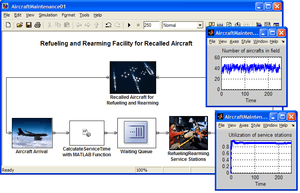SimEvents
 | |
|
SimEvents model showing resource allocation at an aircraft refueling facility | |
| Developer(s) | MathWorks |
|---|---|
| Stable release | R2012a / March 1, 2012 |
| Operating system | Cross-platform[1] |
| Type | List of discrete event simulation software |
| License | Proprietary |
| Website | SimEvents |
SimEvents is a discrete event simulation tool developed by MathWorks. It adds a library of graphical building blocks for modeling queuing systems to the Simulink environment. It also adds an event-based simulation engine to the time-based simulation engine in Simulink [2]
Common uses
Process/Logistics simulation
SimEvents is used to model process flows and logistics in order to understand resource availability, inventory management techniques, and the effects of arbitrary events on a mission plan.
For example, SimEvents can simulate manufacturing processes for capacity planning and production planning, or maintenance scheduling. [3]
Modeling performance of a system architecture
SimEvents is used to build a discrete-event model of the architecture of an electronic system. This architecture model simulates the transactions between different components such as processors, memory, or a communication bus. Simulation of this model provides plots of performance characteristics such as throughput, latency, packet loss and utilization. Systems engineers can use this model to understand the constraints on various shared resources in the electronic system[4]
Capabilities
SimEvents provides a graphical drag-and-drop interface for building a discrete-event model.[5]
It provides libraries of entity generators, random number generators, queues, servers, graphical displays and statistics reporting blocks.[6]
Integration with MATLAB allows customization of the process flow in a SimEvents model. A MATLAB function can be developed to represent a task-scheduling sequence, routing of parts, or production recipes in a process flow. Since the two programs are within the same tools environment, it is straightforward to generate custom random distributions of input tasks, optimize a process, as well as to generate custom statistics.[7]
SimEvents and Simulink can be used in the same simulation model to simulate hybrid or multi-domain systems that have both time-based and event-based components.[8]
See also
References
- ↑ MathWorks - SimEvents - Requirements
- ↑ Cassandras, Christos (2007-11-27). "Introduction to Discrete-Event Simulation". Springer US. Retrieved 2009-11-03.
- ↑ Bender, Alex (2009-07-13). "Effects of decay uncertainty in the prediction of life-cycle costing for large scale military capability projects". 18th World IMACS / MODSIM Congress, Cairns, Australia. Retrieved 2009-11-04.
- ↑ Apte, Anuja (2008-03-01). "Modeling System Architecture and Resource Constraints Using Discrete-Event Simulation". MATLAB Digest - March 2008. Retrieved 2009-11-04.
- ↑ Gray, Michael (2007-11-01). "Discrete Event Simulation: A review of SimEvents". Computing in Science and Engineering, vol. 9, no. 6, pp. 62-66. Retrieved 2009-11-04.
- ↑ Gray, Michael (2007-11-01). "Discrete Event Simulation: A review of SimEvents". Computing in Science and Engineering, vol. 9, no. 6, pp. 62-66. Retrieved 2009-11-04.
- ↑ Gray, Michael (2007-11-01). "Discrete Event Simulation: A review of SimEvents". Computing in Science and Engineering, vol. 9, no. 6, pp. 62-66. Retrieved 2009-11-04.
- ↑ Cassandras, Christos (2006-06-07). "Hybrid system simulation with SimEvents". Second IFAC Conference on Analysis and Design of Hybrid Systems, 2006. Retrieved 2009-11-04.
